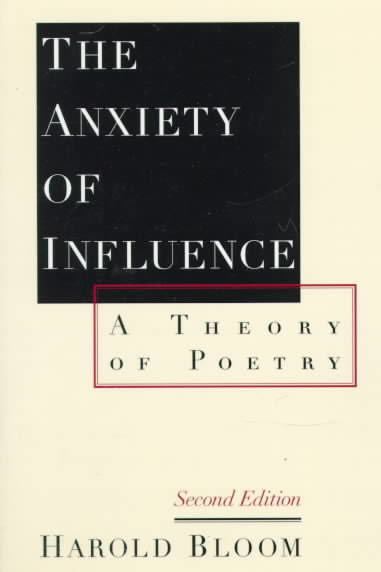7.6 /10 1 Votes7.6
Country United States Subject Literary criticism Media type Print Originally published 1973 Genre Poetry | 3.8/5 Goodreads Language English Publication date 1973 ISBN 0-19-511221-0 | |||||||||||||||||||||||||||||||||
 | ||||||||||||||||||||||||||||||||||
Similar Harold Bloom books, Poetry books | ||||||||||||||||||||||||||||||||||
The anxiety of influence by harold bloom review
The Anxiety of Influence: A Theory of Poetry is a 1973 book by Harold Bloom. It was the first in a series of books that advanced a new "revisionary" or antithetical approach to literary criticism. Bloom's central thesis is that poets are hindered in their creative process by the ambiguous relationship they necessarily maintained with precursor poets. While admitting the influence of extraliterary experience on every poet, he argues that "the poet in a poet" is inspired to write by reading another poet's poetry and will tend to produce work that is in danger of being derivative of existing poetry, and, therefore, weak. Because poets historically emphasize an original poetic vision in order to guarantee their survival into posterity (i.e., to guarantee that future readers will not allow them to be forgotten), the influence of precursor poets inspires a sense of anxiety in living poets. Thus Bloom attempts to work out the process by which the small minority of 'strong' poets manage to create original work in spite of the pressure of influence. Such an agon, Bloom argues, depends on six revisionary ratios, which reflect Freudian and quasi-Freudian defense mechanisms, as well as the tropes of classical rhetoric.
Contents
Before writing this book, Bloom spent a decade studying the Romantic poets of the early nineteenth century. This is reflected in the emphasis given to those poets and their struggle with the influence of John Milton, Robert Browning, and Edmund Spenser. Other poets analyzed range from Lucretius and Dante to Walt Whitman, Wallace Stevens, and John Ashbery. In The Anxiety of Influence and other early books, Bloom claimed that influence was particularly important for post-enlightenment poets. Conversely, he suggested that influence might have been less of a problem for such poets as Shakespeare and Ben Jonson. Bloom since has changed his mind, and the most recent editions of The Anxiety of Influence include a preface claiming that Shakespeare was troubled early in his career by the influence of Christopher Marlowe. The book itself is divided into six major categories, called "six revisionary ratios" by Bloom. They are clinamen, tessera, kenosis, daemonization, askesis, and apophrades.
The six revisionary ratios
Bloom introduces his six revisionary ratios in the following manner, which he consistently applies in this book as well as his successor volume titled A Map of Misreading.
